![]()
![]()
![]()
Use LEFT and RIGHT arrow keys to navigate between flashcards;
Use UP and DOWN arrow keys to flip the card;
H to show hint;
A reads text to speech;
50 Cards in this Set
- Front
- Back
|
Siliciclastic
|
1. Dominantly silicate minerals
2. Erosion and transportation in the solid form 3. Forms >2/3 sedimentary rocks 4. Also called A. Detrital B. Terrigineous C. Epiclastic |
|
|
Classification of Sediment and Sedimentary Rocks
|
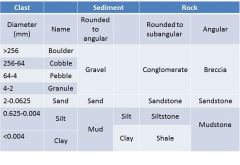
|
|
|
Gravel, Conglomerate, and Breccia
|
~2 % of sedimentary rocks
|
|
|
Poorly Rounded Grains
|
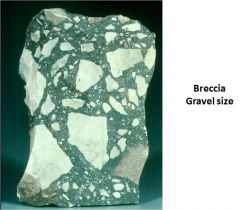
|
|
|
Well Rounded Grains
|
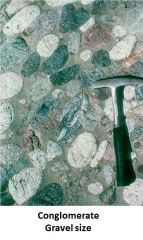
|
|
|
Composition
|
1. Gravel
A. Rock fragments B. Major minerals (sometimes) - Quartz - Feldspar 2. Sand A. Quartz B. Feldspar C. Minor minerals - Feldspar - Micas - Heavy minerals * Garnet, tourmaline, epidote, hornblende, augite, zircon, etc 3. Mud A. Silt B. clay |
|
|
Rock Fragments
|
1. More durable = more abundant
A. Quartzite B. Well cemented sandstone C. Basalt 2. Labile – less abundant A. Shale B. Limestone C. Weakly cemented sandstone |
|
|
Texture: Size
|
1. Grain-supported
A. Interclast matrix (sand, silt and clay) B. Interclast voids 2. Matrix supported A. Clasts “floating” in matrix (sand, silt, and clay) |
|
|
Texture: Sorting
|

1. Grain supported
A. Bimodal B. Polymodal C. River bed load 2. Matrix supported (diamicton) A. Polymodal - Glaciers B. Mass movements C. Debris Flows or Mudflows D. Turbidity currents |
|
|
Texture: clast shape
|
1. Rock type
A. Equant - Quartzite - Granite B. Elongate - Thin-bedded rocks - Foliated metamorphic rocks 2. Abrasion history A. Wind faceting B. Glacier faceting |
|
|
Texture: Grain Surface
|
1. Striations
A. Glaciers 2. Gouges, crescentric-shaped pits A. High velocity streams 3. Surface polishing A. Wind B. Gastroliths (stomach stones, rare) |
|
|
Texture: Grain Arrangement
|
1. Imbrication
A. Stream B. Dip upstream 2. Fabric A. Long axis parallel to flow B. Glacier 3. Random orientation A. Mass movements B. Subaerial and subaqueous debris flows |
|
|
Origin
|
1. Intrabasinal
A. High flow velocity and shear stress 2. Extrabasinal A. Glacial till or tillite B. Tectonics has disrupted basins |
|
|
Bimodal Origin
|
1. Deposited by fluid flow
A. Streams - Gravel lag - Gravel bars B. Heavy surf - Near shore and down current from gravel sources |
|
|
Polymodal Origin
|
1. Glacial till or tillite
2. Turbidites 3. Mass movements A. Alluvial fans B. Colluvial fans 4. Some river gravels A. Clay can infiltrate into voids B. Gravel bars 5. Volcanic Tuff 6. Weathered gravels A. Pedogenic clay can form |
|
|
Glacial Till
|
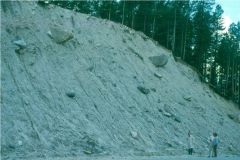
|
|
|
Bedding
|
1. Bedded
A. Fluvial B. Colluvial 2. Massive A. Glacial B. Glacial-marine dropstones C. Volcanic ejecta D. Mass movements E. Turbidity flows - graded bedding |
|
|
Poorly bedded Conclomerates: Alluvial Fan
|
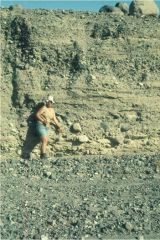
|
|
|
Impact Breccias
|
1. Bolide impact
A. Inside and adjacent to crater B. Tsunami deposit |
|
|
Sandstones
|
1. Most studied clastic sedimentary rocks
A. Common B. Exposed C. Grains large enough to be examined D. Reservoir rocks - Groundwater - Petroleum 2. Arenites 3. Psammites |
|
|
Makeup
|
1. Clasts
A. Size 2-0.625 mm B. Detrital grains 2. Cement A. Authigenic crystals 3. Voids (pore space) A. Air B.Liquids - Water - Oil |
|
|
Clast Composition: Quartz
|
1. Quartz in Thin Section
A. Monocrystalline B. Polycrystalline C. Undulose extinction - High-grade Metamorphic - Plutonic D. Nonundulose extinction - Volcanic - Recycled sandstone |
|
|
Clast Composition: Feldspar
|
1. Feldspar
A. Prior chemical weathering not extensive - Dry climate - Short time B. K feldspar (K) more common - Orthoclase - Microcline - Sanidine C. Plagioclase (Na-Ca) less common D. In hand specimen – white-chalky |
|
|
Clast Composition: Lithic fragments
|
1. Rock (Lithic) Fragments
A. Common B. Difficult to distinguish in hand specimen - Volcanic rocks - Finely crystalline silicate metamorphic rocks * Slate * Phyllite - Chert - Shale C. Not common - Plutonic rocks: Coarsely crystalline silicate metamorphic rocks * Schist * Gneiss |
|
|
Clast Composition: Accessory minerals
|
1. Accessory minerals (heavy minerals)
A. Density > 2.7 g/cm3 B. Smaller than quartz and feldspar C. Examples - Garnet, rutile, zircon, corundum, kyanite, olivene, pyroxenes, amphiboles 2. Some are green or black in hand specimen |
|
|
Clast Composition: Micas
|
1. Micas
A. Larger than quartz grains B. May aid in provenance 2. Shiny in hand specimen |
|
|
Texture
|
1. Size
2. Sorting 3. Shape – roundness to angular 4. Surface characteristics 5. Arrangement or fabric 6. In Hand specimen A. Grain size chart B. Sieving |
|
|
Phi scale
|
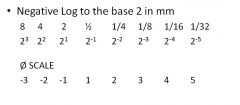
1. Grain Diameter in phi units =
2. Negative Log to the base 2 in mm |
|
|
Histogram
|
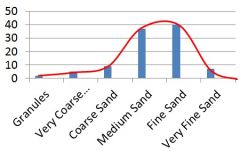
1. Bar graph
A. Abundance of each size class 2. Frequency curve B. Curve fitted to the histogram 3. Shows modes |
|
|
Cumulative Histogram
|
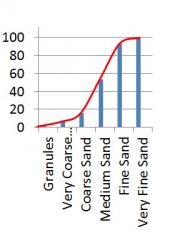
1. Cumulative Weight Percent
2. Cumulative Frequency Diagram 3. Probability Curve vertical scale is logrithmic A. Steep Slopes - better sorted B. Gradual slopes - poorly sorted |
|
|
Grain Size Determination
|
1. Transportation agent
A. Velocity B. Viscosity 2. Inheritance A. What is available 3. Diagenesis A. Grains break down |
|
|
Grain Shape and Roundness
|
1. Shape
A. Inherited 2. Roundness A. Abrasion - Hardness - Cleavage - Velocity - Viscosity - Slow |
|
|
Grain Surface
|
1. Need microscope to identify
2. Pitting 3. Etching 4. Frosting A. Aeolian common |
|
|
Grain Packing
|

1. Cubic
A. Relatively high porosity (~50%) 2. Rhomobohedral A. Relatively low porosity (~25%) B. More abundant with time and compaction |
|
|
Textural Maturity
|
1. Proportion of fine silt and clay
2. Sorting of Sand 3. Roundness of sand grains |
|
|
Immature Sandstones
|
1. Poorly sorted
A. >5% clay and fine silt 2. Poorly rounded 3. Commonly abundant feldspar and lithics (rock fragments) 4. Common in A. Alluvial fan deposit B. Turbidite deposit C. Fluvial overbank deposit D. Neritic (shallow water marine below low tide) deposit |
|
|
Submature Sandstones
|
1. Sorting
A. <5% fine silt and clay 2. Poor rounding A. subangular 3. Feldspar and lithics (rock fragments) common 4. Common in A. Turbidite deposits B. Fluvial channel deposit C. Neritic (shallow water marine below low tide) deposit |
|
|
Mature Sandstone
|
1. Well sorted
A. <5% fine silt and clay 2. Well rounded A. Subangular to subrounded 3. Very little to no feldspar or lithics (rock fragments) A. chert may be present 4. Common in A. Beach deposits B. Eolian dune deposits |
|
|
Supermature Sandstones
|
1. Sorting
A. <5% fine silt and clay 2. Rounding A. rounded 3. Virtually not feldspar or lithics (rock fragments) A. May have chert 4. Common in A. Beach and off shore bar deposit B. Eolian deposit |
|
|
Sandstone Classification
|
1. % Matrix
A. Clastic B. Silt and clay C. > 15% = Wackes - “Dirty” argillaceous immature D. < 15% = Arenites - Clean, cemented submature, mature, or supermature |
|
|
Sandstone triangle
|

|
|
|
Sandstone Classification
|

1. Arenites
2. Wackes 3. Mudstones |
|
|
Sandstone Classification
|
1. Composition of sand fragments
A. Quartz - Quartz arenite (orthoquartzite) - Wackestone (graywacke) B. Feldspar - Feldspathic arenite (arkose) - Wackestone (graywacke) C. Lithic fragments - Lithic arenite (sublitharenites) - Wackestone (graywacke) D. Others clasts ignored |
|
|
Maturity and Environment of Deposition
|
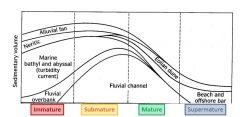
1. Immature
2. Submature 3. Mature 4. Supermature |
|
|
Quartz Arenite
|
1. White to light gray (quartz dominant)
2. Supermature A. Rounded B. Well sorted 3. Bedding common 4. Fossils (except trace) uncommon 5. Source A. Recycled B. Volcanic 6. Geometry A. Regional blanket deposits 103 to 106 km2 B. Stable craton C. Trangressive - Beach - nearshore D. Margins interbedded - Mudstones - Limestones and dolomites conglomerates 7. Age A. Late Precambrian to early Paleozoic |
|
|
Environments of Deposition - Arenites
|
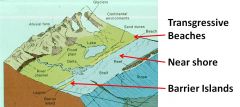
1. Transgressive beaches
2. Near shore 3. Barrier Islands |
|
|
Feldspathic (Arkositc) Arenite
|
1. White, gray or pink (40-50% feldspar)
2. Mature to submature A. Medium-grained sand B. Not well sorted C. Subrounded to subangular 3. Bedding may be present 4. Fossils rare 5. Geometry A. Regional restricted B. Thin discontinuous basal trangressive C. Wedge-shaped fan (alluvial or deltaic) D. Lense-shaped fluvial E. Dry or steep source area 6. Source A. Granite or gneiss 7. Age – common except Archean |
|
|
Environment of Deposition Feldspathic Arenites
|

1. Alluvial fans
2. Fan deltas 3. Fluvial channels |
|
|
Wackes
|
1. Dark colored (clay + Quartz/Feldspar/Lithics)
2. Immature A. Rounded to angular B. Bimodal to polymodal - Matrix due in part from decomposition of lithic clasts 3. Graded Bedding common 4. Fossils A. Deep water fossils common B. Retransported shallow water fossils common 5. Source A. Narrow emergent volcanic arcs 6. Geometry A. Wedge-shaped turbidites B. Thin abyssal - plain beds 7. Age A. Common Archean B. Limited thoughout rest of Precambrian, Paleozoic, Mesozoic, Cenozic |
|
|
Environments of Deposition - Wackes
|
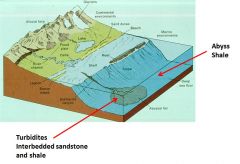
1. Tubidites
A. Interbedded sandstone and shale 2. Abyss shale |

